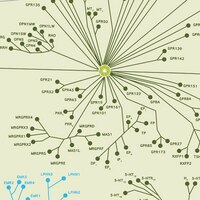HTS092M Sigma-AldrichChemiSCREEN™ EP3 Prostanoid Receptor Membrane Preparation
Human EP3 GPCR membrane preparation for Radioligand binding Assays & GTPgammaS binding.
More>> Human EP3 GPCR membrane preparation for Radioligand binding Assays & GTPgammaS binding. Less<<お勧めの製品
概要
| Replacement Information |
|---|
主要スペック表
| Species | Host Cells | Protein Target |
|---|---|---|
| Human | Chem-1 | EP3 |
| References |
|---|
| Product Information | |
|---|---|
| Format | Membranes |
| Presentation | One package contains enough membranes for at least 200 assays (units), where a unit is the amount of membrane that will yield greater than 10-fold signal:background with 3H-labeled PGE2 at 1.5 nM Liquid in packaging buffer: 50 mM Tris pH 7.4, 10% glycerol and 1% BSA no preservatives. Packaging method: Membranes protein were adjusted to 0.5 mg/ml in 1 ml packaging buffer, rapidly frozen, and stored at -80°C. |
| Quality Level | MQ100 |
| Physicochemical Information |
|---|
| Dimensions |
|---|
| Materials Information |
|---|
| Toxicological Information |
|---|
| Safety Information according to GHS |
|---|
| Safety Information |
|---|
| Storage and Shipping Information | |
|---|---|
| Storage Conditions | Maintain frozen at -70°C for up to 2 years. Do not freeze and thaw. |
| Packaging Information | |
|---|---|
| Material Size | 200 assays |
| Transport Information |
|---|
| Supplemental Information |
|---|
| Specifications |
|---|
| Global Trade Item Number | |
|---|---|
| カタログ番号 | GTIN |
| HTS092M | 04053252363351 |
Documentation
ChemiSCREEN™ EP3 Prostanoid Receptor Membrane Preparation (M)SDS
| タイトル |
|---|
ChemiSCREEN™ EP3 Prostanoid Receptor Membrane Preparation 試験成績書(CoA)
| タイトル | ロット番号 |
|---|---|
| ChemiScreenTM MEMBRANE PREPARATION RECOMBINANT HUMAN EP3 PROSTANOID RECEPTOR - 2089081 | 2089081 |
| ChemiScreenTM MEMBRANE PREPARATION RECOMBINANT HUMAN EP3 PROSTANOID RECEPTOR - 2196298 | 2196298 |
参考資料
| 参考資料の概要 | Pub Med ID |
|---|---|
| Genetic and pharmacological analysis of prostanoid receptor function Narumiya, S and FitzGerald, G A J Clin Invest, 108:25-30 (2001) 2001 | 11435452
 |
| Impaired febrile response in mice lacking the prostaglandin E receptor subtype EP3 Ushikubi, F, et al Nature, 395:281-4 (1998) 1998 | 9751056
 |
| Structural organization of the human prostaglandin EP3 receptor subtype gene (PTGER3) Kotani, M, et al Genomics, 40:425-34 (1997) 1997 | 9073510
 |
| Molecular cloning and expression of multiple isoforms of human prostaglandin E receptor EP3 subtype generated by alternative messenger RNA splicing: multiple second messenger systems and tissue-specific distributions Kotani, M, et al Mol Pharmacol, 48:869-79 (1995) 1995 | 7476918
 |









